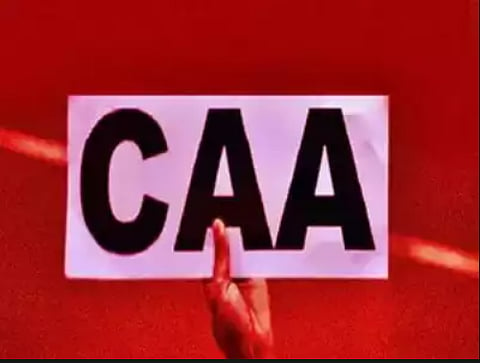
New Delhi: More than four years after the contentious bill was enacted by Parliament in December 2019, the Citizenship Amendment Act (CAA) is now set to be implemented after the Center published the CAA’s Rules on March 11.
Thousands of immigrants from Pakistan, Bangladesh and Afghanistan, who came to India before December 31, 2014 and who wish to apply for Indian citizenship, will benefit from the legislation. These people are either long-term visa (LTV) holders or illegal residents of India.
As required by the Citizenship Act, 1955, the CAA seeks to confer citizenship to the targeted group of migrants even in the event that they lack legitimate travel documentation. The CAA assumes that Hindus, Sikhs, Christians, Buddhist, Jains and Parsis were “persecuted” for their religious beliefs in Pakistan, Afghanistan and Bangladesh before traveling to India. Additionally, the statute has shortened the 11-year citizenship by naturalization duration to five years. In order to apply for Indian citizenship, immigrants from these nations are only required to provide documentation of their place of origin, religion, date of admission into India and proficiency in the language.
There has been a major relaxation in the new regulation. Documents such as passports issued by Afghanistan, Bangladesh or Pakistan and a copy of a current Indian residency permit are no more required.
The CAA Rules state that documents required to prove the applicant’s citizenship in their respective countries include “birth certificates, certificates from educational institutions, identity documents of any kind, any license or certificate, land or tenancy records and any other document” issued by the nations.
Documents demonstrating that “one or both of the applicant’s parents, grandparents or great grandparents is or was a citizen of one of the three countries” are also admissible.
Notably, these documents will remain admissible even beyond their validity period. These records, according to sources, will also be utilized to prove the applicant’s religious affiliation.
The need for an educational institution’s certificate, attesting to the applicant’s proficiency in one of the languages listed in the Eighth Schedule of the Constitution, has also been done away. Now, just saying so and being able to communicate in the language will be sufficient.
There are 20 documents listed in the Rules, all of which can be used to prove the applicant’s date of entrance into India.
The documents include a valid visa or residential permit issued by the Foreigners’ Regional Registration Office (FRRO); a slip from an Indian census enumerator; a driving license, Aadhaar, ration card, or any letter from the government or a court; an Indian birth certificate; land or tenancy records; a registered rent agreement; a PAN card issuance document or a document from the central or state government, PSU or bank; a certificate from an elected member of any rural or urban body or an officer thereof; a post office account; an insurance policy; utility bills; court or tribunal records; Employee Provident Fund (EPF) documents; a school leaving certificate or academic certificate; a municipality trade license; or a marriage certificate.
A visa was essential earlier along with a few additional documents.
States run by Opposition parties, including West Bengal and Kerala, have declared they will not abide by the CAA.
But according to the Rules, the Center has changed the procedure for awarding citizenship to non-Muslim immigrants from the three nations in a way that will largely limit the influence of the states.
Therefore, the new Rules provide for an Empowered Committee and a District Level Committee (DLC), to be instituted by the Center, to receive and process citizenship applications, which are to be submitted electronically.
The committee will make the judgment after applications have been submitted to the DLC. It will be led by a director (Census Operations), and its members will include the state postmaster general (under the Union Ministry of Communications), the FRRO, the State Informatics Officer of the National Informatics Center (under the Ministry of Electronics & Information Technology) and an officer of the Subsidiary Intelligence Bureau (under the Ministry of Home Affairs) with the rank of deputy secretary or above.
The State Home Department and the Railways will each send a representative to the committee.
The district informatics officer or the district informatics assistant will be appointed as the DLC. Two invitees to the committee will be the jurisdictional station master of the Railways (subject to availability) and a representative from the district collector’s office, not lower than the rank of Naib Tehsildar or equivalent.
Previously, citizenship applications were made to the district collector, who is under the administrative control of the state government.
Also Read-
You can also join our WhatsApp group to get premium and selected news of The Mooknayak on WhatsApp. Click here to join the WhatsApp group.